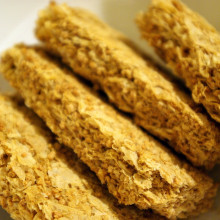Have you ever noticed how leaving bits of leftover breakfast cereal uneaten causes it to harden like cement to the side of the bowl? Why is this? We explore the science of cereal cement, with additional commentary from Dominic Ford. Plus, we ask if earthquakes are becoming more commonplace.
In this episode

00:00 - Why does dried cereal stick to the bowl?
Why does dried cereal stick to the bowl?
We put this to Peter Belton, Professor of chemistry at the University of East Anglia... Peter - The question was why does cereal stick to plates and cups and so on when it's dry? It's to do with the starch. Starch is essentially a glue. So that like any glue, it will stick things to other things. The reason starch is a glue is that it's a polymer. That means that it's very long and it has many ways of attaching itself to a surface. So when the cereal is wet, the starch sits on the surface and as it dries, the polymer gets stiffer, so it's harder and harder to pull the cereal off. When it's very dry, it's a bit like a piece of concrete and so, it sticks very hard. If you soak the material and leave it for a while, the polymers will soften up and get to be able to move again, and you'll be able to pull them off.
Diana - And are there any practical applications for this property?
Peter - Well it's used in paper paste for example and I don't know what children do at school now but when I was a kid at school, we use to make glue out of starch and water and stick things together with it. I suppose if you're desperate and you need to stick two things together, a bit of flour and water paste will actually work.
Dominic - So the starch in the weetabix is made up of very long molecules. These are suspended in the milk and tangle with each other, but as the milk dries out, starch settles onto the surface of the bowl where the parts of the starch molecule wedge themselves into microscope nooks and crannies on the bowl's surface. So now, not only are they tangled around each other, but they're also hooked into the surface of the bowl. Once it's dry, it's much harder for them to move to untangle themselves. So they form the equivalent of concrete made out of cereal. So, if you want to do the washing up without a chisel, you first have to soak the bowl, re-suspending the starch, and then the molecules can move past one another and you can scrub the bowl clean.









Comments
Add a comment